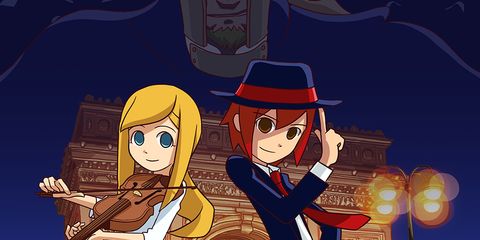All too often, we as gamers read the cries that too many videogames lack originality. However, even if a game has obvious inspirations, that doesn’t mean it deserves immediate rejection. On Nintendo handhelds worldwide, but particularly in Japan, Professor Layton’s anime-infused, Euro-centric approach to puzzle gaming is exceptionally popular, so it’s tough to fault Sega for following in the professor’s footsteps. The imitation is even more forgivable since Rhythm Thief and the Emperor’s Treasure has just enough new approaches to separate it from its inspiration while remaining entertaining.
The Rhythm Thief in question is Phantom R, a high class, gentlemanly thief who’s pilfering the art world of Paris. When R isn’t evading the constables, his alter ego Raphael is researching a centuries-old conspiracy that leads back to the mysterious disappearance of his father and an equally enigmatic orphan girl named Marie. We were quickly invested in the rich mystery of the plot, thanks in no small part to the title’s gorgeous rendering of Paris, France. In both the gameplay and impressive anime cutscenes, The City of Light looks spectacular.
If you think the plot sounds like it’s from the same mold as Layton, the game’s structure is even closer. You walk around the open world of Gay Paree finding people in need of help or clues that lead to the apparent resurrection of Napoléon Bonaparte. The key difference between Layton and Rhythm Thief is that you progress through the city not by completing increasingly dense logic puzzles, but by solving problems via the art of dance. Unlike the brain-bending conundrums of Layton, Thief challenges an entirely different set of skills as you do your best to keep the beat in melodic minigame.
The great variety of minigames at your disposal in Rhythm Thief is the portable title’s strongest asset. Sometimes you’re dancing, other times you’re throwing steaks to your dog, and occasionally you’re fighting your way out of the hidden catacombs of Paris. That level of diversity applies to how the minigames take advantage of many 3DS features, too. Inputs fluctuate between tilting the system, tapping the touch screen, or using the face buttons. The amusing unpredictability of what you’ll be asked to do next keeps you on your toes.
There are dozens of different songs to play along with, the challenge escalating with each chapter of the story. Players that can’t keep a beat shouldn’t worry too much, as the bar for completing a song is pretty low and you can spend in-game currency before every song on items to make things easier. However, even when we knew that we could get away with less, we often were so engaged that we pushed ourselves to get at least an A on the standard difficulty, whether the first time around or when we chose to replay from the menu.
The songs themselves are enjoyable when you’re experiencing them but mostly forgettable other than a few standouts. We loved select tunes like the Rhythm Thief theme and Moon Princess, but many others left our ears as fast as they entered them. Of course, occasionally Rhythm Thief really surprised us with a taste of that old Sega magic, as our crusty hearts were warmed by stages that gave tribute to Samba de Amigo and Space Channel 5. It was endearing to see Rhythm Thief recognize its musical Sega heritage with flourishes of fan service.
Outside of a mostly unmemorable soundtrack, our only real complaint about Rhythm Thief is its overreliance on fetch quests. The campaign is long enough without them, but about once per chapter, we hit the speed bump that forced us to transport an item from one side of Paris to the other. We enjoyed running around the city in search of hidden items and other extras, but the overreliance on fetch quests to bulk up playtime felt more and more contrived with each instance.

One can complain that Rhythm Thief and the Emperor’s Treasure isn’t all that new, but it often takes the portable puzzle-adventure genre to new heights via an abundance of addictive minigames. The cute aesthetics and animation that borrows heavily from the films of Studio Ghibli are a great way to convey a collection of musical diversions that can be played in big chunks or on a leisurely bus ride. If you’re looking for that type of portable entertainment – or are a Sega fan that misses the developer’s heyday – you’ll want to visit Rhythm Thief’s Paris ASAP.


